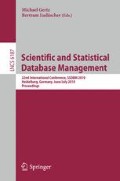Abstract
Traditionally, a convoy is defined as a set of moving objects that are close to each other for a period of time. Existing techniques, following this traditional definition, cannot find evolving convoys with dynamic members and do not have any monitoring aspect in their design. We propose new concepts of dynamic convoys and evolving convoys, which reflect real-life scenarios, and develop algorithms to discover evolving convoys in an incremental manner.
Access this chapter
Tax calculation will be finalised at checkout
Purchases are for personal use only
Preview
Unable to display preview. Download preview PDF.
References
Gudmundsson, J., van Kreveld, M.: Computing longest duration flocks in trajectory data. In: GIS 2006: Proceedings of the 14th annual ACM international symposium on Advances in geographic information systems, pp. 35–42. ACM, New York (2006)
Benkert, M., Gudmundsson, J., Hübner, F., Wolle, T.: Reporting flock patterns. Comput. Geom. Theory Appl. 41(3), 111–125 (2008)
Hwang, S.Y., Liu, Y.H., Chiu, J.K., Lim, E.P.: Mining mobile group patterns: A trajectory-based approach. In: Ho, T.-B., Cheung, D.W.L., Liu, H. (eds.) PAKDD 2005. LNCS (LNAI), vol. 3518, pp. 713–718. Springer, Heidelberg (2005)
Wang, Y., Lim, E.P., Hwang, S.Y.: Efficient algorithms for mining maximal valid groups. The VLDB Journal 17(3), 515–535 (2008)
Jeung, H., Yiu, M.L., Zhou, X., Jensen, C.S., Shen, H.T.: Discovery of convoys in trajectory databases. Proc. VLDB Endow. 1(1), 1068–1080 (2008)
Kalnis, P., Mamoulis, N., Bakiras, S.: On discovering moving clusters in spatio-temporal data. In: Bauzer Medeiros, C., Egenhofer, M.J., Bertino, E. (eds.) SSTD 2005. LNCS, vol. 3633, pp. 364–381. Springer, Heidelberg (2005)
Guha, S., Rastogi, R., Shim, K.: CURE: an efficient clustering algorithm for large databases, pp. 73–84 (1998)
Karypis, G., Han, E.H.S., Kumar, V.: Chameleon: A hierarchical clustering algorithm using dynamic modeling (1999)
Alsabti, K., Ranka, S., Singh, V.: An efficient k-means clustering algorithm. In: Proceedings of IPPS/SPDP Workshop on High Performance Data Mining (1998)
Ng, R.T., Han, J.: Clarans: A method for clustering objects for spatial data mining. IEEE Trans. on Knowl. and Data Eng. 14(5), 1003–1016 (2002)
Ester, M., peter Kriegel, H., Sander, J., Xu, X.: A density-based algorithm for discovering clusters in large spatial databases with noise, pp. 226–231. AAAI Press, Menlo Park (1996)
Ester, M., Kriegel, H.P., Sander, J., Wimmer, M., Xu, X.: Incremental clustering for mining in a data warehousing environment. In: VLDB 1998: Proceedings of the 24th International Conference on Very Large Data Bases, pp. 323–333. Morgan Kaufmann, San Francisco (1998)
Spiliopoulou, M., Ntoutsi, I., Theodoridis, Y., Schult, R.: Monic: modeling and monitoring cluster transitions. In: KDD 2006: Proceedings of the 12th ACM SIGKDD international conference on Knowledge discovery and data mining, pp. 706–711. ACM, New York (2006)
Vieira, M.R., Bakalov, P., Tsotras, V.J.: On-line discovery of flock patterns in spatio-temporal data. In: Agrawal, D., Aref, W.G., Lu, C.T., Mokbel, M.F., Scheuermann, P., Shahabi, C., Wolfson, O. (eds.) GIS, pp. 286–295. ACM, New York (2009)
Rhee, I., Shin, M., Hong, S., Lee, K., Kim, S., Chong, S.: CRAWDAD data set ncsu/mobilitymodels (v. 2009-07-23), http://crawdad.cs.dartmouth.edu/ncsu/mobilitymodels (July 2009)
Jetcheva, J.G., Hu, Y.C., PalChaudhuri, S., Saha, A.K., Johnson, D.B.: CRAWDAD data set rice/ad_hoc_city (v. 2003-09-11), http://crawdad.cs.dartmouth.edu/rice/ad_hoc_city (September 2003)
Author information
Authors and Affiliations
Editor information
Editors and Affiliations
Rights and permissions
Copyright information
© 2010 Springer-Verlag Berlin Heidelberg
About this paper
Cite this paper
Aung, H.H., Tan, KL. (2010). Discovery of Evolving Convoys. In: Gertz, M., Ludäscher, B. (eds) Scientific and Statistical Database Management. SSDBM 2010. Lecture Notes in Computer Science, vol 6187. Springer, Berlin, Heidelberg. https://doi.org/10.1007/978-3-642-13818-8_16
Download citation
DOI: https://doi.org/10.1007/978-3-642-13818-8_16
Publisher Name: Springer, Berlin, Heidelberg
Print ISBN: 978-3-642-13817-1
Online ISBN: 978-3-642-13818-8
eBook Packages: Computer ScienceComputer Science (R0)

